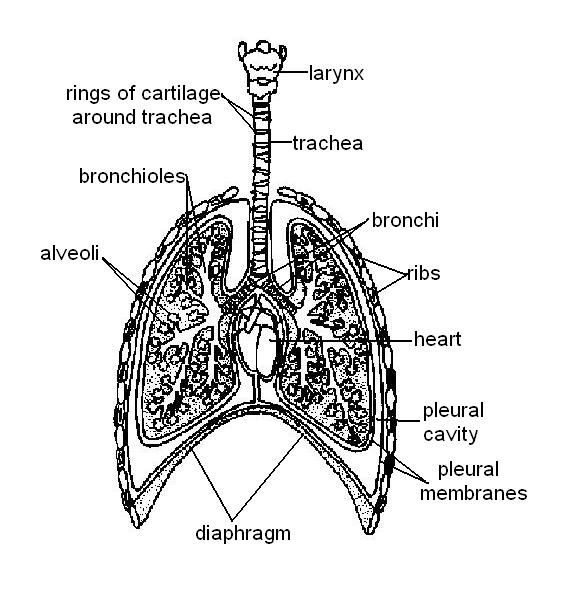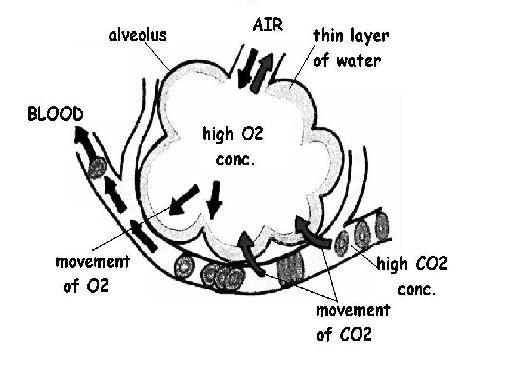The Anatomy and Physiology of Animals/Respiratory System Worksheet/Worksheet Answers
1. Add labels to the diagram of the respiratory system of a dog below:
2. List the structures below in the order in which air passes them as it travels from the nose to the lungs
- pharynx; larynx; trachea; bronchi; bronchioles; alveoli
3. Which is the odd one out?
- trachea; oesophagus; nasal cavity; larynx; bronchi; bronchioles.
The oesophagus is part of the digestive system. The rest are parts of the respiratory system.
4. How are dust particles that enter the respiratory system in the air expelled? They become enmeshed in the mucus produced by cells lining the respiratory tract. They are then transported to the nose by the beating of the cilia that also line the trachea, bronchi and bronchioles.
5. Add the correct terms from the list below to the following descriptions.
- a) Smallest respiratory passageways. C. Bronchioles
- b) Separates the mouth from the nose. D. Palate
- d) Windpipe. B. Trachea
- e) Where gas exchange takes place. A. Alveoli
- f) Stops food “going the wrong way” i.e. choking during swallowing. I. Epiglottis
- g) Both air and food pass through this. G. Pharynx
- h) The movement of air out of the lungs. H. Expiration
- i) The main muscle involved in inspiration. F. Diaphragm
- j) Membranes that cover the lungs and line the pleural cavity. E. Pleura
- k) The volume of air inhaled or exhaled at each normal breath. J. Tidal volume
6. Arrange these statements in the right order to describe inspiration.
- B. The muscles between the ribs contract to move the ribs up and out
- D. The diaphragm contracts and flattens
- A. The air pressure in the air tight pleural cavities decreases
- E. The lungs expand to fill the space created
- C. Air is drawn down the trachea into the lungs
Note: B and D occur together so the order can be BDAEC or DBAEC
7. True or false?
- a) The pericardium is the membrane surrounding the lungs. F. The membrane surrounding the lungs is the pleural membrane. The pericardium surrounds the heart.
- b) The tidal volume describes the maximum amount of air that can be inhaled into the lungs. F. This is the vital capacity. The tidal volume is the volume of air that is inhaled or exhaled in one normal at rest breath.
- c) Tidal volume can be measured with a peak flow meter F. A peak flow meter measures the force with which air can be blown out of the lungs.It does not measure volume. Tidal volume can be measured with any device that traps and then measures the volume of air expelled from the lungs during a normal "at rest" breath.
- d) Inspiration takes up energy but expiration (during normal at rest breathing) is a passive process not normally requiring energy. T.
- e) The diaphragm is made of smooth muscle. F. The diaphragm is made of skeletal muscle. The contraction of the diaphragm is under conscious control and skeletal muscle is the only muscle under conscious control.
- f) The epiglottis closes off the larynx during swallowing. T
- g) The rate of breathing is controlled by the pituitary gland. F. It is controlled by respiratory centres in the medulla oblongata (and the pons).
- h) When an animal exercises the rate of breathing increases because the carbon dioxide in the blood increases. T.
- i) Carbon dioxide dissolved in the blood makes the blood alkaline. F. Dissolved CO2 makes blood acidic.
- j) Carbon dioxide in the blood is mainly carried in the blood plasma. T
- k) Oxygen moves from the alveoli into the capillaries by the process of osmosis. F. Oxygen moves by diffusion.
- l) Expired air contains about 16% oxygen. T.
8. Add the following labels to the diagram of lung alveoli below.
- alveolus; thin layer of water; area of high oxygen concentration;
- area of high carbon dioxide concentration; movement of oxygen; movement of carbon dioxide;
- air moves in and out of alveoli; blood flowing along capillary.
9. Which of the statements below gives the best definition of gas exchange?
:d) exchanging oxygen for carbon dioxide in the lung alveoli.
10. Which of the following help the lungs to be such good gas exchange organs? (Choose at least 4).
- They have a large surface area.
- The air in the alveoli and blood in the capillaries are separated by a 2 very thin layers of cells.
- The blood flows more slowly in the lung capillaries as they are so narrow.
- Breathing constantly changes the air in the alveoli.
11. Add the terms from the list below to the blanks in the following statements.
The process of gas exchange is by (1) F. Diffusion.
When substances pass in this manner, they move from areas of (2) G. Higher concentration to areas of their (3) H. Lower concentration.
Thus in the alveoli of the lungs oxygen continually passes from the (4) B. Air of the alveoli to the blood in the capillary and then in the tissues from the (5) E. Capillary blood to tissue cells.
Conversely in the tissues carbon dioxide moves from the(6) J. Tissue cells to capillary blood and in the lungs from the (7) D. Capillary blood to alveolar air.
From there it passes out of the body during expiration. As a result of gas exchange, the blood in (most) arteries tends to be (8) C. Carbon dioxide -poor and oxygen –rich while the blood in (most) veins is (9) I. Oxygen-poor and carbon dioxide – rich.

